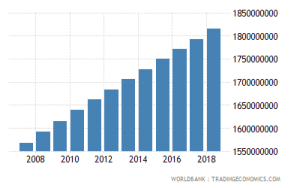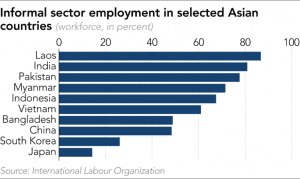Reading Time: 5 minutes
Navodita analyses the policy outlook that will outline some of the key common challenges as well as advantages associated with South Asia when it comes to fighting COVID-19, along with some unique country-level priorities. An exclusive for Different Truths.
 As COVID-19 creates havoc around the world, and with the World Health Organisation (WHO) describing it as a ‘pandemic’, governments have had to scramble to manage the spread and impact. South Asia, namely Pakistan, India, Bangladesh, Sri Lanka, Nepal, Maldives, Afghanistan and Bhutan have begun to experience what is being described as ‘phase three’ of the COVID-19 pandemic as of late March 2020. This development comes after the disease spread widely among local communities. In contrast, during ‘phase two’, the transmission was predominantly traced back to arrivals from foreign countries. As the Coronavirus spreads, the fight against this disease has accelerated both in terms of prevention and cure. This policy outlook will outline some of the key common challenges as well as advantages associated with South Asia when it comes to fighting COVID-19, along with some unique country-level priorities.
As COVID-19 creates havoc around the world, and with the World Health Organisation (WHO) describing it as a ‘pandemic’, governments have had to scramble to manage the spread and impact. South Asia, namely Pakistan, India, Bangladesh, Sri Lanka, Nepal, Maldives, Afghanistan and Bhutan have begun to experience what is being described as ‘phase three’ of the COVID-19 pandemic as of late March 2020. This development comes after the disease spread widely among local communities. In contrast, during ‘phase two’, the transmission was predominantly traced back to arrivals from foreign countries. As the Coronavirus spreads, the fight against this disease has accelerated both in terms of prevention and cure. This policy outlook will outline some of the key common challenges as well as advantages associated with South Asia when it comes to fighting COVID-19, along with some unique country-level priorities.
As COVID-19 creates havoc around the world, and with the World Health Organisation (WHO) describing it as a ‘pandemic’, governments have had to scramble to manage the spread and impact. South Asia, namely Pakistan, India, Bangladesh, Sri Lanka, Nepal, Maldives, Afghanistan and Bhutan have begun to experience what is being described as ‘phase three’ of the COVID-19 pandemic as of late March 2020. This development comes after the disease spread widely among local communities
Considering countries in the region fair similarly on multiple demographic, socioeconomic and human development indicators, this section focuses on common advantages that may be at play in South Asian nations’ fight against the Novel Coronavirus. Firstly, the median age across South Asia is 27.6 years. As the Novel Coronavirus is believed to be deadlier for the elderly, who are also more likely to be hospitalised and thus potentially overwhelm health systems, this may be an advantage. Secondly, South Asia as a region may be what is come to be known as ‘behind the curve’ when it comes to COVID-19 infection and having learned from other worse affected regions, may be able to apply lessons learned effectively to ‘flatten the curve’. As of March 26, 2020, despite the low numbers of cases of Novel Coronavirus regionally, Sri Lanka has imposed a strict indefinite curfew, India has imposed a 21-day complete lockdown (which got extended), Nepal has closed its borders, and while Pakistan and Bangladesh have not compelled lockdowns, social distancing measures have been undertaken.
Furthermore, the military has been deployed in both countries to help civil administrations enforce preventative measures. Even in Afghanistan, the Taliban, who have been historically sceptical of global health organisations, have confirmed that it was ready to cooperate with the WHO.
According to World Bank data, population density in South Asia was 380 people per square km in 2018, making it one of the most densely populated regions in the world. This makes social distancing very difficult, as many people live in close quarters with their families and neighbours and share facilities such as toilets.
According to World Bank data, population density in South Asia was 380 people per square km in 2018, making it one of the most densely populated regions in the world. This makes social distancing very difficult, as many people live in close

quarters with their families and neighbours and share facilities such as toilets. Lack of access to clean water and disinfectants is common, and with regional air pollution reaching alarming levels, managing a full-blown Novel Coronavirus outbreak is expected to be a nightmare.
On top of that, South Asian countries do not have advanced healthcare systems. For example, India has one doctor per 2000 people (the WHO recommends a doctor-patient ratio of 1:1000), while Pakistan has approximately 2000 ventilators in preparation for the COVID-19 outbreak. Somewhat ironically, both are reported to have rapidly expanding nuclear weapon arsenals. South Asian countries tend to historically underspend on health care. Quarantine arrangements have been lacking severely in multiple countries, including India and Pakistan. In the case of Pakistan, the poorly managed quarantine facilities on the Pakistan-Iran border were considered the source of most positive cases of COVID-19 in the country.
South Asian countries do not have advanced healthcare systems. For example, India has one doctor per 2000 people (the WHO recommends a doctor-patient ratio of 1:1000), while Pakistan has approximately 2000 ventilators in preparation for the COVID-19 outbreak. Somewhat ironically, both are reported to have rapidly expanding nuclear weapon arsenals.
Given the massive constraints, governments have opted for measures such as enforced lockdowns and curfews. While they can be considered pre-emptive measures in order to avoid what is likely to be an unmanageable situation, the impact of such measures on the economies of South Asia is expected to be enormous.
This is firstly since, as data from the International Labour Organisation (ILO) shows, most South Asian countries have very high numbers of informal workers. For example, Nepal, India and Pakistan have informal employment rates of 91%, 81% and 78% respectively. As per the ILO, informal employment is defined as ‘all remunerative work (i.e. both self-employment and wage employment) that is not registered, regulated or protected by existing legal or regulatory frameworks, as well as non-remunerative work undertaken in an income-producing enterprise. Informal workers do not have secure employment contracts, workers’ benefits, social protection or workers’ representation. That means that in India, for example, which has implemented a 21- day lockdown with no measures such as government food programs or cash transfer programs, more than eight out of 10 people (81%) are employed informally. This is significant as many informal workers do not have job security, and lockdowns mean loss of critical income. Experts are warning that lockdowns and curfews without support measures in place may lead to a desperate situation, particularly for informal workers earning daily wages. This is already evident in India where many daily labourers believe the lockdown amounts to an ‘order to starve’, particularly when backed up by the threat of policy violence.
This is firstly since, as data from the International Labour Organisation (ILO) shows, most South Asian countries have very high numbers of informal workers. For example, Nepal, India and Pakistan have informal employment rates of 91%, 81% and 78% respectively.
Food security is also a problem in Sri Lanka, where a curfew has been imposed. It is

not unreasonable to expect conflict, potentially in the form of riots or violent protests, to follow soon after. Such workers are also more likely to seek out work, thereby increasing their risk of infection and possibly becoming carriers. Secondly, some economies in South Asia, such as Nepal and the Maldives are heavily reliant on tourism. In Nepal, more than a million jobs are generated by the industry. Tourism has become the main driver of the economy in land-locked Nepal. The Novel Coronavirus outbreak in neighbouring countries as well as in countries that are the source of much of Nepal’s tourism (India, the United States and China) has generated panic in the country. Nepal, with just three confirmed cases of COVID-19 as of March 26, 2020, with no deaths and one person having recovered already, has sealed its borders as a preventative measure. However, this is likely to create havoc for the country’s economy as more time passes.
Adequate planning and foresightedness alone can help the current government in combating the pandemic in an effective way.
Photo from the Internet
















